
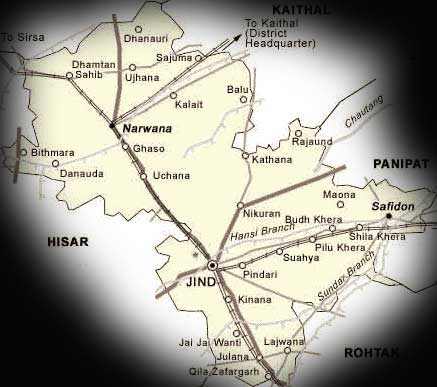
The principality was founded in 1763, and the chief was recognized by the Mogul emperor in 1768. The dynasty has always been famous for its loyalty to the British, especially during the Mutiny, which has been rewarded with accessions of territory. In 1857 the raja of Jind was actually the first man, European or native, who took the field against the mutineers; and his contingent collected supplies in advance for the British troops marching upon Delhi, besides rendering excellent service during the siege. Raja Ranbir Singh succeeded as a minor in 1887, and was granted full powers in 1899. During the Tirah expedition of 1897/98 the Jind imperial service infantry specially distinguished themselves. The town of Jind, the former capital, has a station on the Southern Punjab railway, 80 m. N.W. of Delhi. Pop. (1901), 8047. The present capital and residence of the raja since 1827 is Sangrur; pop. (1901), 11,852.
JIND STATE (history):
One
Gajpat Singh, a great grandson of Phul, the founder of the Phulkian Misl, one
of the 12 confederacies of the Sikhs in the 18th century. He took part in the
attack of the Sikhs on the province of Sirhind in 1763 in which Zain Khan, The
Afghan governor of the province was killed. Gajpat Singh occupied a large tract
of the country including Jind and Safidon as his share of the spoil. He made Jind
his headquarters and built a large brick fort there.
In 1772, Emperor Shah
Alam conferred upon Gajpat Singh the title of Raja. From this time onward, the
Sikh chief ruled as an independent prince and coined money in his own name The
Delhi authority failed several times to bring him under its control. In 1774 a
serious quarrel arose between Gajpat Singh and Himir Singh , the then ruler of
Nabha . Gajpat singh used force and took possession of Amloh Bhadson and Sangrur
,by the intervention of the ruler of Patiala and other friends . The first two
places were restored to Nabha but Sangrur then a village was retained.
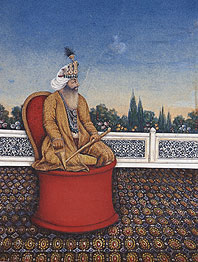
Raja Gajpat Singh
Raja Gajpat Singh's Daughter Bibi Kaur married
Sardar Mahan Singh Sukrachakla and became the mother of famous Maharaja Ranjit
Singh. This must have enhanced Gajpat Singh's prestige. Moreover his strategic
position in the North-Western corner of the Rohtak region made it easy for him
to have his hold over some parts of Haryana -Gohana, Hisar etc. which he and his
successors held until the beginning of the last century.
Raja Gajpat Singh
died in 1786 and was succeeded by his son Bhag Singh at a very tough time. But
he overcame this serious menace with the help of his brother chief of the Cis-Satluj
tract and the Marathas.
Bhag Singh was a shrewd man. He was the first of all
the Cis-Satluj princes to seek an alliance with the British . In 1803 he assisted
Lord Lake in his way against the Marathas and received confirmation of the Gohana
estate. He also prevented his nephew Maharaja Ranjit Singh from espousing the
cause of Jaswant Rao Holkar,.The British recognised in him a great friend and
ally and showed him many marks of favour and regard.
Raja Bhag Singh suffered
a severe paralytic attack in March 1813. Unfit to run the administration of his
state, the ailing chief wished to appoint Prince Pratap Singh the ablest and wisest
of all his sons as his regent to do his work . But the British government to whom
the anti-British bearing of the prince was known stood in his way and got Rani
Sobrahi appointed in place of the prince in 1814. This was unbearable for Partap
Singh and he raised the standard of revolt on June 23, 1814. He being a popular
figure the state forces also revolted and joined him forth with. With their help
the prince lost no time in occupying the Jind fort and established his government
after putting the Rani the puppet of the British government to the sword.
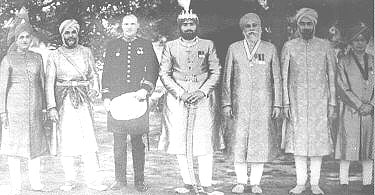
Maharaja Partap Singh with aides and a British Officer
This alarmed
the British authorities very much and the British resident at Delhi sent his force
against Pratap Singh , the prince thinking that he would not be able to give a
fight to this force from the Jind fort, retired to a relatively stronger position
at Balanwati , a fort in the wild country about Bhatinda. The British attacked
him with full force and after a fierce fighting for some time Pratap Singh had
to leave this fort and take his position in the country on the other bank of the
Satluj after crossing it at Makhowal . Here he was joined by Phula Singh Akali.
Pratap
Singh remained with Phula Singh at Nanpur Mokhowal for two months and persuaded
the latter to assist him actively at Balanwali. When the British came to know
that Phula Singh had crossed the Satluj, they directed Nabha and Malerkotla rulers
to attack him. Balanwali was then invaded by Patiala troops and was almost prepared
to surrender when its defenders heard the approach of Phula Singh. They at once
broke the negotiations while Pratap Singh went in advance and with a few men threw
himself into the fort. The Patiala troops marched to intercept Phula Singh who
was unable to relieve the fort and retired towards the Satluj. The British directed
Nabha and Kaithal chiefs to help Patiala troops. Balanwali Surrendered and Pratap
Singh was taken a prisoner and was placed under merely a nominal restraint. Pratap
Singh later fled to Lahore. Maharaja Ranjit Singh refused to give a shelter to
Pratap Singh and gave him up to the British who placed him in confinement at Delhi
where he died in 1816.
The administration of Jind was entrusted to prince Fateh
Singh. Though Raja Bhag Singh did not like the arrangement, yet he did not oppose
it. In fact, he had neither the will nor the means to do it. Bhag Singh died in
1819, and Fateh Singh succeeded him. He ruled for a short time only and died three
years later (1822). Now Sangat Singh, (11 years old) succeeded him.
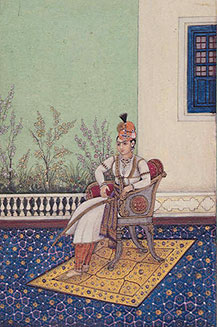
Raja Sangat Singh (1822 -1834)
He hated the authority of the
British which the latter noted with grave concern. But, before they could think
of dealing with him he died a sudden death on November 2, 1834. Annoyed as the
British Government was with the deceased Raja, they forfeited a number of his
estates in Ludhiana, Mudki, etc. (about 150 villages) and in the trans-Satluj
region (Halwara, Talwandi, etc.). The latter estates were given to Ranjit Singh.
Since
the deceased Raja left no male heir behind him, Sarup Singh, his cousin succeeded
him. He was very friendly and loyal to British, but not to his people, especially
of Balanwali. They did not relish the change and organised themselves to oppose
him. Gulab Singh Gill, formerly a Risaldar in Jind army and Dal Singh, brother-in-law
of Prince Pratap Singh, were their leaders. The rebels got a good deal of inspiration
from Mai Sul Rai, the widow of Prince Pratap Singh. A British force was dispatched
against the rebels in early 1835. By March the ranks of the rebels had swelled
a good deal. The people of the neighboring villages like Bhai Chakian, etc. and
the Akalis of Gurusar, a place of pilgrimage had joined hands with them. The villagers
fought well, but being inferior to their enemy in military knowledge, strategy
and tactics, arms and ammunitions, they lost the day. Their casualties in the
action were quite heavy, Gulab Singh being one of them. Dal Singh and Mai Rai
were apprehended and put behind the bars, along with their supporters. And thus
ended a popular revolt after much bloodshed and cruelty on the part of the British
government.
Raja Sarup Singh gave great help to the British government for
his selfish motives. In 1857, immediately on learning of the outbreak, he conducted
his troops to Karnal by forced marches and undertook the defence of the city and
cantonment. He then sent a detachment of his troops to north of Delhi, thus enabling
the Meerut force to cross the Yamuna and join Sir H. Barnard's column. The Jind
forces marched in advance of the British army recovering Samalkha and Rai, securing
the road and collecting supplies for the army. They were complimented on the field
by the Commander-in-Chief, who sent one of the captured guns to the Raja as a
present. In the assault of Delhi also the Jind troops took a prominent part. Resultingly
Dadri and Kularan were made over to the Raja, privileges of full sovereignty were
granted to him and his successors in perpetuity and honorary titles were conferred
on him
Raja Sarup Singh died in 1864. He was succeeded by his son Raghbir Singh.
Immediately after his installation, Raghbir Singh was faced with a serious revolt
of the peasantry in the newly acquired territory of Dadri. In May 1874, the poor
exploited peasants of about 50 villages in this tract led by their local Chaudharis
and Hakim and Kasim Ali rose en- masse captured police station arrested Thanedar
and proclaimed the end of the Raja's rule. This was a big challenge to Raja who
immediately marched in person at the head of a big army. His first attack was
on Charkhi (14 May), where 1500-2000 persons of the rebellious villages had collected
and entrenched themselves. They resisted the Raja to the last but ultimately they
were defeated and their village was burnt. Next, Mankawas was attacked, captured
and destroyed. However the two defeats did not dishearten the brave villagers
who gave a tough battle to the Raja at Jhauju (16 May). But here also they shared
the same fate and defeat quelled the rebellion once for all. The Raja punished
the leaders but permitted the Zamindar to return and rebuild their ruined villages.
The
Raja also took side of the British Government on the occasion of the Kuka outbreak
in 1872. Again when the second Afghan war broke out six years later he gave help
to the British with man, money, and material. The British government conferred
the title of Raja-i-Rajgan on Raghbir Singh.
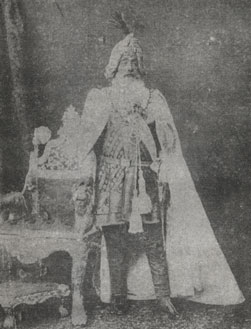
Raja i-Rajgan Raghbir Singh
Raghbir Singh died in 1887.
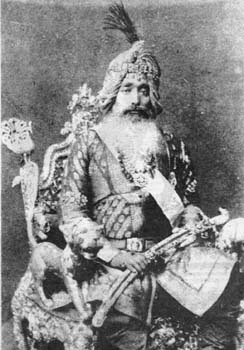
Raja-i-Rajgan Raghbir Singh (1832-1887)
His only son Balbir singh had died during his own lifetime and therefore his grandson, Ranbir Singh, Then only 8 years of age, succeeded him. During the period of his minority, a council of regency administered the state, during this regime the state troops took part in the Tirah campaign of 1897. He was interested in full ruling powers in November 1899.
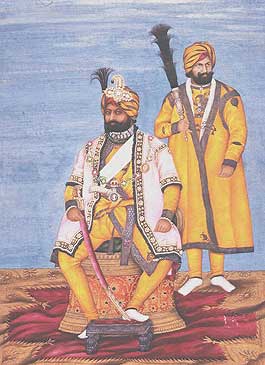
Maharaja Ranbir Singh
During the first world war, Jind maintained
its loyal tradition by placing all the resources of his state at the disposal
of the government .The Jind Imperial Service Regiment was on active service for
about three and half years in East Africa; States war gift amounted to over 24
lacs ; while the total loan raised in the state amounted to eleven and half lacs.The
British Government thanked the Maharaja very heartily after the war .
PRAJA
MANDAL MOVEMENT :
The Raja as indicated above was very loyal to the British
but indifferent toward the prosperity of his subjects. Instead of looking after
their welfare, he effected their economic exploitation. The poor and ignorant
masses groaned under the exploitation by the Raja.
In the first quarter of
the present century when winds of political awakening and enlightenment reached
even the remotest corners of the country , the people of Jind were also affected
. They became conscious of their pitiable conditions and began to ponder over
has to how to get over these difficulties . The formation of all India state pepole's
conference in 1927 at the Punjab state Riyasti Paraja Mandal the following years
showed them the way . They too , established the Jind state Parja Mandal however
in the condition which were then in vogue , No open memberhip drive of the Mandal
was possible . Members were recruited secretly . Parja Mandal would appear to
have been established at Narwana . and other places in sport of National movement
The Sikh peasants joined the Paraja Mandal Movement and they launched the stir
against the Raja . The agitators as they were called then led their main attack
on the enhanced revenue rates., corruption and high- handedness of the Chief Minister
of the State Raja Ranbir Singh took a stiff attitude and the stir does not seem
to have achieved any big success but this did not dishearten the people.
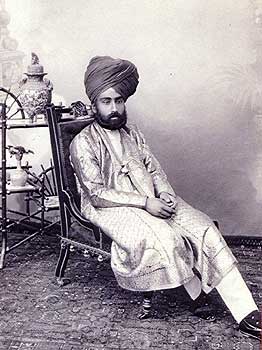
Maharaja Ranbir Singh
In the late Thirties the Parja Mandal Movement
sepread to almost all parts of the state, the branches of Parja Mandal were opened
at Sangrur, Dadri, Jind and at several big villages in the region.
The Praja
Mandalist waged a long stubborn struggle for the reduction of taxes, abolition
of begar and popular representation in the Government. Their efforts bore fruits,
through belated and the Raja accepted their demand for an elected assembly and
formed a representative government on 18th January, 1947 with five ministers;
two Praja Mandalists, two Akalies, and one Muslim. The Raja had power to veto
any decision of his cabinet.
This arrangement did not satisfy the people especially
in the Dadri region, where they rose in revolt in February, 1947. They courted
arrests in large number and formed a parallel government of their own. This compelled
the Jind authorities to invite the president of the All India State Peoples Conference
for negotiations. On his advice the people withdrew the movement. The state authorities
promised to look into their grievances and released all the Praja Mandalists who
had been arrested.
When India got independence (August, 1947), a non-official
poll was taken by the Jind State Praja Mandal in Jind and Dadri to ascertain the
views of the people about their future whether they wanted to merge with Punjab
or stood for a separate state. The majority of people voted for the former proposal
. But the government merged the state with the newly- created state of Patiala
and East Punjab State Union(PEPSU) on July 15, 1948
With the formation of the
Patiala and East Punjab States Union (PEPSU) in 1948, the state was grouped into
eight districts namely, Patiala, Barnala, Bhatinda, Kapurthala, Fatehgarh Sahib,
Sangrur, Mahendragarh and Kohistan(Kandaghat). In 1953, the number of districts
was reduced to five, by merging Barnala with Sangrur and Kandaghat and Fatehgarh
Sahib with Patiala. Thus the Sangrur district comprised five tahsils, namely,
Barnala, Malerkotla, Sangrur, Narwana and Jind.
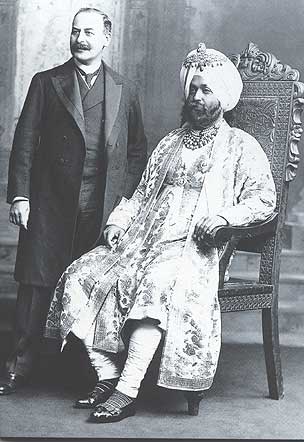
H.H.Farzand-i-Dilband Rasikh-ul-Daulat-i-Inglishia Raja-i-Rajagan Raja Ranbir Singh Bahadur, Maharaja of Jind (1879-1948) with an unidentified English Gentleman. Photo taken 25th Sept. 1906 (photo courtesy The Lafayette studio-Russel Harris)
During the reorganization of the Punjab in 1966, the Sangrur district was bifurcated and Jind and Narwana tahsils were allocated to Haryana and were constituted into Jind district. The Jind tahsil was bifurcated into two tahsils of Jind and Safidon in 1967. In January 1973, 54 villages of Kaithal tahsil were transferred to Jind district, 43 going to Jind tahsil, 5 to Safidon tahsil and 6 to Narwana tahsil. One village namely, Barsola was transferred to Jind tahsil from Hansi tahsil of Hisar district in 1974.
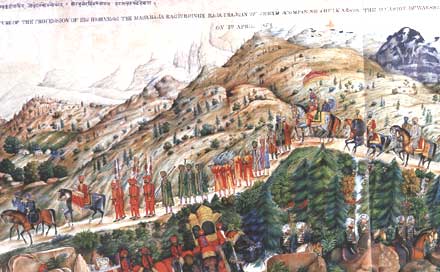
Picture of the procession of His Highness the Maharaja Ragbir Singh Raja-I-Rajgan of Jeend accompanying Ahulkars on the occasion of Worship of Jwalamukhi on 3rd April 1878
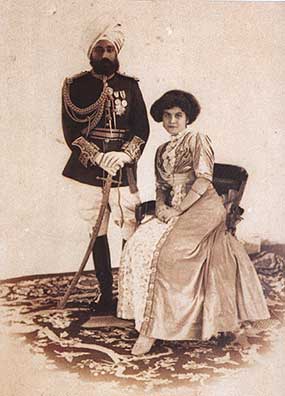
Maharaja Ranbir Singh with his Romanian wife, Olive.
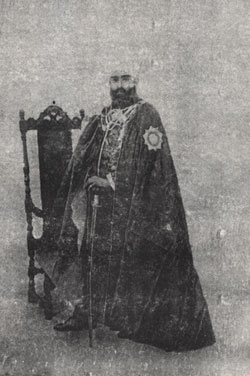
Raja Ranbir Singh